Lights and Shadows: A Comprehensive Survey on Cooperative and Precoding Schemes to Overcome LOS Blockage and Interference in Indoor VLC
Abstract
:1. Introduction
- In Section 2, the system model for VLC is analyzed, presenting a brief overview of the single and multi carrier modulation schemes. The network requirements for implementing cooperative and precoding schemes are presented considering the transmitter, receiver and network architectures, which involve parameters such as dynamic range, noise, field of view (FoV) or the need for backhaul links between transmitters, among others.
- Section 3 motivates the need for employing cooperative schemes in VLC scenarios and presents the state of the art cooperative techniques for VLC published in the literature. Fundamentals of every cooperative technique are described and compared to its counterparts.
- Section 4 is devoted to introducing the concept of precoding schemes from the signal processing perspective and for analyzing their application to VLC systems. First, the fundamentals of precoding schemes and its particularities for VLC are presented. After that, the differences between the capacity for RF and VLC systems are highlighted. Specifically, for VLC, the typical Shannon capacity equation [36,37], i.e., , where is the signal to noise ratio, does not hold, since the optical channel is amplitude-constrained. In this sense, the lower and upper bounds of the capacity for VLC derived in [38,39,40] are presented. Moreover, the capacity bounds assuming MIMO precoding in VLC systems derived in [34] are analyzed. Finally, we present an evaluation of the state of the art for precoding applied to VLC networks.
- In Section 5, a review of the intra-cluster and inter-cluster interference management in VLC networks is presented, considering the combination of cooperative and precoding schemes. After that, the concept of user-centric clustering is analyzed reviewing the recent works that apply this approach in VLC networks [35]. Furthermore, VLC systems are usually deployed in indoor scenarios, where an umbrella RF system, e.g., WiFi or femtocells, is already available. Enabling cooperation among VLC and RF systems, the concept of hybrid VLC/RF networks is introduced and the recent works in the field are analyzed.
- In Section 6, remaining challenges and open issues for cooperative and precoding schemes in VLC networks subject to shadowing are outlined. These challenges comprise adapting the transmission schemes to limited backhaul links, modeling the channel state information (CSI) prediction for users mobility, uncorrelating the channel responses among users, novel user-centric clustering schemes or the application of the massive MIMO concept to VLC.
2. Modeling the VLC Networks: Architecture, System Model and Scenarios
2.1. VLC Architecture
2.1.1. Transmitter
Single-Carrier Modulations
Multi-Carrier Modulations
2.1.2. Receiver
2.1.3. Backhaul Link
2.2. System Model
2.3. Scenarios
3. Cooperative Schemes
3.1. Introduction to Cooperative Schemes
3.2. Cooperative Schemes for VLC
3.2.1. Frequency Reuse (FR)
3.2.2. Joint Transmission—Coordinated Multipoint (Jt-Comp)
3.2.3. Pre-Defined Jt-Comp
3.2.4. Relay-Based Cooperative Techniques
3.2.5. Other Techniques
4. Precoding Schemes
4.1. Introduction to Precoding Schemes
4.1.1. Fundamentals
4.1.2. Requirements for VLC Precoding Schemes
4.1.3. Capacity of Mimo VLC Systems
4.2. Precoding Schemes for VLC
4.2.1. Linear ZF Precoding
4.2.2. Minimum Mean Squared Error (Mmse)
4.2.3. Other Precoding Techniques
4.2.4. Non-Perfect CSI
4.2.5. Blind Interference Alignment
5. Precoding as Cooperative and Hybrid Networks
5.1. Clustering for VLC. Intra-Cluster and Inter-Cluster Interference
5.2. User-Centric VLC Networks
5.3. Hybrid RF/VLC Networks
6. Open Issues for Cooperative and Precoding Schemes in VLC
6.1. Realistic Backhaul Links
6.2. Angle Diversity Receivers for Overcoming the Shadowing and Blocking Effects
6.3. Is the Concept of Massive Mimo Applicable to VLC?
6.4. User-Centric Approaches for Precoding Schemes
6.5. CSI Prediction for Mobility
7. Conclusions
Author Contributions
Funding
Conflicts of Interest
References
- Hanzo, L.; Haas, H.; Imre, S.; O’Brien, D.; Rupp, M.; Gyongyosi, L. Wireless myths, realities, and futures: From 3G/4G to optical and quantum wireless. Proc. IEEE 2012, 100, 1853–1888. [Google Scholar] [CrossRef]
- Rehman, S.U.; Ullah, S.; Chong, P.H.J.; Yongchareon, S.; Komosny, D. Visible light communication: A system perspective, overview and challenges. Sensors 2019, 2019, 1153. [Google Scholar] [CrossRef] [PubMed] [Green Version]
- Chataut, R.; Akl, R. Massive MIMO systems for 5G and beyond networks overview, recent trends, challenges, and future research direction. Sensors 2020, 20, 2753. [Google Scholar] [CrossRef] [PubMed]
- Genoves Guzman, B.; Gil Jimenez, V.P.; Aguayo-Torres, M.C.; Haas, H.; Hanzo, L. Downlink performance of optical OFDM in outdoor visible light communication. IEEE Access 2018, 6, 76854–76866. [Google Scholar] [CrossRef]
- Delgado-Rajo, F.; Melian-Segura, A.; Perez-Jimenez, R.; Sanchez-Rodriguez, D. Hybrid RF/VLC network architecture for the internet of things. Sensors 2020, 20, 478. [Google Scholar] [CrossRef] [PubMed] [Green Version]
- Rahman, A.; Li, T.; Wang, Y. Recent advances in indoor localization via visible lights: A survey. Sensors 2020, 20, 1382. [Google Scholar] [CrossRef] [PubMed] [Green Version]
- Ratosi, M.; Simon, G. Robust VLC beacon identification for indoor camera-based localization systems. Sensors 2020, 20, 2522. [Google Scholar] [CrossRef] [PubMed]
- Alsalami, F.M.; Ahmad, Z.; Zvanovec, S.; Haigh, P.A.; Haas, O.C.L.; Rajbhandari, S. Indoor intruder tracking using visible light communications. Sensors 2019, 19, 4578. [Google Scholar] [CrossRef] [Green Version]
- Tagliaferri, D.; Capsoni, C. Enabling on-aircraft visible-light communications in low-light conditions. Electron. Lett. 2019, 55, 274–276. [Google Scholar] [CrossRef]
- Kim, D.; Yang, S.; Kim, H.; Son, Y.; Han, S. Outdoor visible light communication for inter-vehicle communication using controller area network. In Proceedings of the International Conference on Communications and Electronics (ICCE), Hue, Vietnam, 1 August 2012; pp. 31–34. [Google Scholar]
- Cailean, A.; Dimian, M. Current challenges for visible light communications usage in vehicle applications: A survey. IEEE Commun. Surv. Tutors 2017, 19, 2681–2703. [Google Scholar] [CrossRef]
- Cuba-Zúñiga, D.; Mafra, S.B.; Mejía-Salazar, R.J. Cooperative full-duplex V2V-VLC in rectilinear and curved roadway scenarios. Sensors 2020, 20, 3734. [Google Scholar] [CrossRef] [PubMed]
- Chen, Q.; Zheng, W.; Zhang, T.; Cui, W.; Cui, Z. A power analysis model for outdoor long-distance visible light communication. In Proceedings of the International Conference on Ubiquitous and Future Networks (ICUFN), Sydney, Australia, 1–3 August 2017; pp. 131–136. [Google Scholar]
- Zhang, M.; Zhao, P.; Jia, Y. A 5.7 Km visible light communications experiment demonstration. In Proceedings of the International Conference on Ubiquitous and Future Networks, Sapporo, Japan, 7–10 July 2015; pp. 58–60. [Google Scholar]
- Wang, Y.; Huang, X.; Tao, L.; Chi, N. 1.8-Gb/s WDM visible light communication over 50-meter outdoor free space transmission employing CAP modulation and receiver diversity technology. In Proceedings of the Optical Fiber Communications Conference and Exhibition (OFC), Los Angeles, CA, USA, 22–26 March 2015; pp. 1–3. [Google Scholar]
- Rajagopal, S.; Roberts, R.D.; Lim, S. IEEE 802.15.7 visible light communication: Modulation schemes and dimming support. IEEE Commun. Mag. 2012, 50, 72–82. [Google Scholar] [CrossRef]
- IEEE 802.11bb. IEEE 802.11 Light Communication TG 2017. Available online: https://www.ieee802.org/11/Reports/tgbb_update.htm (accessed on 17 June 2020).
- Chen, C.; Basnayaka, D.A.; Haas, H. Downlink performance of optical attocell networks. J. Lightw. Technol. 2016, 34, 137–156. [Google Scholar] [CrossRef]
- Yang, H.; Zhong, W.D.; Chen, C.; Alphones, A. Integration of visible light communication and positioning within 5G networks for internet of things. IEEE Net. 2020, 34, 134–140. [Google Scholar] [CrossRef]
- Elgala, H.; Mesleh, R.; Haas, H. Indoor broadcasting via white LEDs and OFDM. IEEE Trans. Consum. Electron. 2009, 55, 1127–1134. [Google Scholar] [CrossRef]
- Wang, Z.; Tsonev, D.; Videv, S.; Haas, H. On the design of a solar-panel receiver for optical wireless communications with simultaneous energy harvesting. IEEE J. Sel. Areas Commun. 2015, 33, 1612–1623. [Google Scholar] [CrossRef]
- Takai, I.; Ito, S.; Yasutomi, K.; Kagawa, K.; Andoh, M.; Kawahito, S. LED and CMOS image sensor based optical wireless communication system for automotive applications. IEEE Photon. J. 2013, 5, 6801418. [Google Scholar] [CrossRef]
- Giustiniano, D.; Tippenhauer, N.O.; Mangold, S. Low-complexity visible light networking with LED-to-LED communication. In Proceedings of the IFIP Wireless Days, Dublin, Ireland, 21–23 November 2012; pp. 1–8. [Google Scholar]
- Cheng, L.; Viriyasitavat, W.; Boban, M.; Tsai, H.M. Comparison of radio frequency and visible light propagation channels for vehicular communications. IEEE Access 2017, 6, 2634–2644. [Google Scholar] [CrossRef]
- Blinowski, G. Security of visible light communication systems: A survey. Phys. Commun. 2019, 34, 246–260. [Google Scholar] [CrossRef]
- Chen, C.; Haas, H. Performance evaluation of downlink cooperative multipoint joint transmission in LiFi systems. In Proceedings of the IEEE Globecom Workshops, Singapore, 4–8 December 2017; pp. 1–6. [Google Scholar]
- Beysens, J.; Wang, Q.; Pollin, S. Improving blockage robustness in VLC networks. In Proceedings of the International Conference on COMmmunication Systems and NETworks (COMSNETS), Bangalore, India, 7–11 January 2019. [Google Scholar]
- CitiLed COB Series CLU058-3618C4. Datasheet, Citizen. 2019. Available online: https://ce.citizen.co.jp/lighting_led/dl_data/datasheet/en/COB_5/CLU058-3618C4_P3705_0516.pdf (accessed on 17 June 2020).
- Morales-Céspedes, M.; Paredes-Paredes, M.C.; García Armada, A.; Vandendorpe, L. Aligning the light without channel state information for visible light communications. IEEE J. Sel. Areas Commun. 2018, 36, 91–105. [Google Scholar] [CrossRef]
- Gesbert, D.; Hanly, S.; Huang, H.; Shamai Shitz, S.; Simeone, O.; Yu, W. Multi-cell MIMO cooperative networks: A new look at interference. IEEE J. Sel. Areas Commun. 2010, 28, 1380–1408. [Google Scholar] [CrossRef] [Green Version]
- Guzmán, B.G.; Dowhuszko, A.A.; Jiménez, V.P.G.; Pérez-Neira, A.I. Resource allocation for cooperative transmission in optical wireless cellular networks with illumination requirements. IEEE Trans. Commun. 2020. [Google Scholar] [CrossRef]
- Fath, T.; Haas, H. Performance comparison of MIMO techniques for optical wireless communications in indoor environments. IEEE Trans. Commun. 2013, 61, 733–742. [Google Scholar] [CrossRef]
- Spencer, Q.H.; Swindlehurst, A.L.; Haardt, M. Zero-forcing methods for downlink spatial multiplexing in multiuser MIMO channels. IEEE Trans. Signal Process. 2004, 52, 461–471. [Google Scholar] [CrossRef]
- Pham, T.V.; Le-Minh, H.; Pham, A.T. Multi-user visible light communication broadcast channels with zero-forcing precoding. IEEE Trans. Commun. 2017, 65, 2509–2521. [Google Scholar] [CrossRef]
- Zhang, R.; Wang, J.; Wang, Z.; Xu, Z.; Zhao, C.; Hanzo, L. Visible light communications in heterogeneous networks: Paving the way for user-centric design. IEEE Wireless Commun. 2015, 22, 8–16. [Google Scholar] [CrossRef]
- Shannon, C.E. A mathematical theory of communication. Bell Syst. Tech. J. 1948, 27, 379–423. [Google Scholar] [CrossRef] [Green Version]
- Cover, T.M.; Thomas, J.A. Elements of Information Theory (Wiley Series in Telecommunications and Signal Processing); Wiley-Interscience: New York, NY, USA, 2006. [Google Scholar]
- Farid, A.A.; Hranilovic, S. Upper and lower bounds on the capacity of wireless optical intensity channels. In Proceedings of the IEEE International Symposium on Information Theory, Nice, France, 24–29 June 2007; pp. 2416–2420. [Google Scholar]
- Farid, A.A.; Hranilovic, S. Capacity bounds for wireless optical intensity channels with gaussian noise. IEEE Trans. Inf. Theory 2010, 56, 6066–6077. [Google Scholar] [CrossRef]
- Lapidoth, A.; Moser, S.M.; Wigger, M.A. On the capacity of free-space optical intensity channels. IEEE Trans. Inf. Theory 2009, 55, 4449–4461. [Google Scholar] [CrossRef] [Green Version]
- Pathak, P.H.; Feng, X.; Hu, P.; Mohapatra, P. Visible light communication, networking, and sensing: A survey, potential and challenges. IEEE Commun. Surveys Tutors 2015, 17, 2047–2077. [Google Scholar] [CrossRef]
- Li, X.; Zhang, R.; Hanzo, L. Optimization of visible-light optical wireless systems: Network-centric versus user-centric designs. IEEE Commun. Surv. Tutors 2018, 20, 1878–1904. [Google Scholar] [CrossRef] [Green Version]
- Obeed, M.; Salhab, A.M.; Alouini, M.; Zummo, S.A. On optimizing VLC networks for downlink multi-user transmission: A survey. IEEE Commun. Surv. Tutors 2019, 21, 2947–2976. [Google Scholar] [CrossRef] [Green Version]
- Arfaoui, M.A.; Soltani, M.D.; Tavakkolnia, I.; Ghrayeb, A.; Safari, M.; Assi, C.M.; Haas, H. Physical layer security for visible light communication systems: A survey. IEEE Commun. Surv. Tutors 2020, 22, 1887–1908. [Google Scholar] [CrossRef] [Green Version]
- Guzmán, B.G.; Chen, C.; Jiménez, V.P.G.; Haas, H.; Hanzo, L. Reflection-based relaying techniques in visible light communications: Will it work? IEEE Access 2020, 8, 80922–80935. [Google Scholar] [CrossRef]
- Genovés Guzmán, B.; Dowhuszko, A.A.; Gil Jiménez, V.P.; Pérez-Neira, A.I. Robust cooperative multicarrier transmission scheme for optical wireless cellular networks. IEEE Photon. Technol. Lett. 2018, 30, 197–200. [Google Scholar] [CrossRef]
- Gheth, W.; Rabie, K.M.; Adebisi, B.; Ijaz, M.; Harris, G. Performance analysis of cooperative and non-cooperative relaying over VLC channels. Sensors 2020, 20, 3660. [Google Scholar] [CrossRef]
- Shi, J.; He, J.; Wu, K.; Ma, J. Enhanced performance of asynchronous multi-cell VLC system using OQAM/OFDM-NOMA. J. Lightw. Technol. 2019, 37, 5212–5220. [Google Scholar] [CrossRef]
- Haas, H. High-speed wireless networking using visible light. SPIE Newsroom 2013. [Google Scholar] [CrossRef]
- Chi, N.; Zhou, Y.; Wei, Y.; Hu, F. Visible Light Communication in 6G: Advances, Challenges, and Prospects. IEEE Veh. Tech. Mag. 2020, 15, 93–102. [Google Scholar] [CrossRef]
- James Singh, K.; Huang, Y.M.; Ahmed, T.; Liu, A.C.; Huang Chen, S.W.; Liou, F.J.; Wu, T.; Lin, C.C.; Chow, C.W.; Lin, G.R.; et al. Micro-LED as a Promising Candidate for High-Speed Visible Light Communication. Appl. Sci. 2020, 10, 7384. [Google Scholar] [CrossRef]
- Deng, P.; Kavehrad, M. Effect of white LED DC-bias on modulation speed for visible light communications. arXiv 2016, arXiv:1612.08477. [Google Scholar]
- OSRAM Ostar Series. Datasheet, Citizen. 2019. Available online: https://www.mouser.com/new/osram/osram-OstarStage/ (accessed on 17 June 2020).
- Céspedes, M.M.; García Armada, A. Characterization of the Visible Light Communications during the Construction of Tunnels. In Proceedings of the 16th International Symposium on Wireless Communication Systems, Oulu, Finland, 27–30 August 2019; pp. 356–360. [Google Scholar]
- Khadr, M.H.; Abd El Aziz, A.; Fayed, H.A.; Aly, M. Bandwidth and BER Improvement Employing a Pre-Equalization Circuit with White LED Arrays in a MISO VLC System. Appl. Sci. 2019, 9, 986. [Google Scholar] [CrossRef] [Green Version]
- Bian, R.; Tavakkolnia, I.; Haas, H. 15.73 Gb/s Visible Light Communication With Off-the-Shelf LEDs. J. Lightw. Technol. 2019, 37, 2418–2424. [Google Scholar] [CrossRef] [Green Version]
- Zhou, Y.; Wei, Y.; Hu, F.; Hu, J.; Zhao, Y.; Zhang, J.; Jiang, F.; Chi, N. Comparison of nonlinear equalizers for high-speed visible light communication utilizing silicon substrate phosphorescent white LED. Opt. Express 2020, 28, 2302–2316. [Google Scholar] [CrossRef]
- Islim, M.S.; Ferreira, R.X.; He, X.; Xie, E.; Videv, S.; Viola, S.; Watson, S.; Bamiedakis, N.; Penty, R.V.; White, I.H.; et al. Towards 10 Gb/s orthogonal frequency division multiplexing-based visible light communication using a GaN violet micro-LED. Photon. Res. 2017, 5, A35–A43. [Google Scholar] [CrossRef]
- Zwaag, K.M.; L.C.Neves, J.; R.O.Rocha, H.; E.V.Segatto, M.; A.L.Silva, J. Adaptation to the LEDs flicker requirement in visible light communication systems through CE-OFDM signals. Opt. Commun. 2019, 441, 14–20. [Google Scholar] [CrossRef]
- Wilson, B.; Ghassemlooy, Z. Pulse time modulation techniques for optical communications: A review. IEE Proc. Optoelectron. 1993, 140, 347–357. [Google Scholar] [CrossRef]
- Kahn, J.M.; Barry, J.R. Wireless infrared communications. Proc. IEEE 1997, 85, 265–298. [Google Scholar] [CrossRef] [Green Version]
- Proakis, J. Digital Communications; McGraw-Hill Series in Electrical and Computer Engineering: Communications and Signal Processing; McGraw-Hill: New York, NY, USA, 2001. [Google Scholar]
- Dimitrov, S.; Haas, H. Principles of LED Light Communications: Towards Networked Li-Fi; Cambridge University Press: Cambridge, UK, 2015. [Google Scholar]
- Hwang, T.; Yang, C.; Wu, G.; Li, S.; Ye Li, G. OFDM and its wireless applications: A survey. IEEE Trans. Veh. Technol. 2009, 58, 1673–1694. [Google Scholar] [CrossRef]
- Chen-Hu, K.; Morales-Cespedes, M.; Garcia-Armada, A. OFDM-Based Multicarrier Transmission. In Wiley 5G Ref: The Essential 5G Reference Online; Wiley: New York, NY, USA, 2020; pp. 1–23. [Google Scholar]
- Carruthers, J.B.; Kahn, J.M. Multiple-subcarrier modulation for nondirected wireless infrared communication. IEEE J. Sel. Areas Commun. 1996, 14, 538–546. [Google Scholar] [CrossRef]
- Armstrong, J.; Lowery, A. Power efficient optical OFDM. Electron. Lett. 2006, 42, 370–372. [Google Scholar] [CrossRef] [Green Version]
- Wang, Z.; Wang, Q.; Huang, W.; Xu, Z. Multicarrier Modulation. In Visible Light Communications: Modulation and Signal Processing; Wiley: New York, NY, USA, 2018; pp. 89–145. [Google Scholar]
- Lian, J.; Brandt-Pearce, M. Clipping-enhanced optical OFDM for visible light communication systems. J. Lightw. Technol. 2019, 37, 3324–3332. [Google Scholar] [CrossRef]
- Dissanayake, S.; Armstrong, J. Comparison of ACO-OFDM, DCO-OFDM and ADO-OFDM in IM/DD systems. J. Lightw. Technol. 2013, 31, 1063–1072. [Google Scholar] [CrossRef]
- Thorlabs: Photodiode Tutorial. Available online: https://www.thorlabs.com/tutorials.cfm?tabID=31760 (accessed on 21 October 2020).
- Hamamatsu: Si Photodiodes. Available online: https://www.hamamatsu.com/resources/pdf/ssd/e02_handbook_si_photodiode.pdf (accessed on 21 October 2020).
- Barry, J.R.; Kahn, J.M. Link design for nondirected wireless infrared communications. Appl. Opt. 1995, 34, 3764–3776. [Google Scholar] [CrossRef]
- Chen, C.; Zhong, W.D.; Wu, D. Wide-FOV and High-Gain imaging angle diversity receiver for indoor SDM-VLC Systems. IEEE Photon. Technol. Lett. 2016, 28. [Google Scholar] [CrossRef]
- Chen, C.; Zhong, W.; Wu, D. On the coverage of multiple-input multiple-output visible light communications [Invited]. IEEE/OSA J. Opt. Commun. Netw. 2017, 9, D31–D41. [Google Scholar] [CrossRef]
- Nuwanpriya, A.; Ho, S.; Chen, C.S. Indoor MIMO visible light communications: Novel angle diversity receivers for mobile users. IEEE J. Sel. Areas Commun. 2015, 33, 1780–1792. [Google Scholar] [CrossRef]
- Tavakkolnia, I.; Soltani, M.D.; Arfaoui, M.A.; Ghrayeb, A.; Assi, C.; Safari, M.; Haas, H. MIMO system with multi-directional receiver in optical wireless communications. In Proceedings of the IEEE International Conference on Communications Workshops (ICC Workshops), Shanghai, China, 20–24 May 2019; pp. 1–6. [Google Scholar]
- Morales-Céspedes, M.; Haas, H.; García Armada, A. Optimization of the receiving orientation angle for zero-forcing precoding in VLC. IEEE Commun. Lett. 2020. [Google Scholar] [CrossRef]
- Chen, Z.; Basnayaka, D.A.; Wu, X.; Haas, H. Interference mitigation for indoor optical attocell networks using an angle diversity receiver. J. Lightw. Technol. 2018, 36, 3866–3881. [Google Scholar] [CrossRef] [Green Version]
- Zeng, Z.; Soltani, M.D.; Safari, M.; Haas, H. Angle diversity receiver in LiFi cellular networks. In Proceedings of the IEEE International Conference on Communications (ICC), Shanghai, China, 21–23 May 2019; pp. 1–6. [Google Scholar]
- Hosney, M.; Selmy, H.A.I.; Srivastava, A.; Elsayed, K.M.F. Interference mitigation using angular diversity receiver with efficient channel estimation in MIMO VLC. IEEE Access 2020, 8, 54060–54073. [Google Scholar] [CrossRef]
- Tipmongkolsilp, O.; Zaghloul, S.; Jukan, A. The evolution of cellular backhaul technologies: Current issues and future trends. IEEE Commun. Surv. Tutors 2011, 13, 97–113. [Google Scholar] [CrossRef]
- Song, J.; Ding, W.; Yang, F.; Yang, H.; Yu, B.; Zhang, H. An indoor broadband broadcasting system based on PLC and VLC. IEEE Trans. Broadcast. 2015, 61, 299–308. [Google Scholar] [CrossRef]
- Bouchet, O.; Porcon, P.; Wolf, M.; Grobe, L.; Walewski, J.W.; Nerreter, S.; Langer, K.; Fernández, L.; Vucic, J.; Kamalakis, T.; et al. Visible-light communication system enabling 73 Mb/s data streaming. In Proceedings of the IEEE Globecom Workshops, Miami, FL, USA, 6–10 December 2010; pp. 1042–1046. [Google Scholar]
- Jani, M.; Garg, P.; Gupta, A. Performance analysis of a mixed cooperative PLC–VLC system for indoor communication systems. IEEE Syst. J. 2020, 14, 469–476. [Google Scholar] [CrossRef]
- Delgado, F.; Quintana, I.; Rufo, J.; Rabadan, J.A.; Quintana, C.; Perez-Jimenez, R. Design and implementation of an Ethernet-VLC interface for broadcast transmissions. IEEE Commun. Lett. 2010, 14, 1089–1091. [Google Scholar] [CrossRef]
- Wang, Y.; Chi, N.; Wang, Y.; Tao, L.; Shi, J. Network architecture of a high-speed visible light communication local area network. IEEE Photon. Technol. Lett. 2015, 27, 197–200. [Google Scholar] [CrossRef]
- Lozano, A.; Heath, R.W.; Andrews, J.G. Fundamental limits of cooperation. IEEE Trans. Inf. Theory 2013, 59, 5213–5226. [Google Scholar] [CrossRef] [Green Version]
- Zhao, J.; Quek, T.Q.S.; Lei, Z. Heterogeneous cellular networks using wireless backhaul: Fast admission control and large system analysis. IEEE J. Sel. Areas Commun. 2015, 33, 2128–2143. [Google Scholar] [CrossRef] [Green Version]
- Li, Y.; Pióro, M.; Angelakisi, V. Design of cellular backhaul topology using the FSO technology. In Proceedings of the 2nd International Workshop on Optical Wireless Communications, Newcastle upon Tyne, UK, 21 October 2013; pp. 6–10. [Google Scholar]
- Li, Y.; Pappas, N.; Angelakis, V.; Pióro, M.; Yuan, D. Optimization of free space optical wireless network for cellular backhauling. IEEE J. Sel. Areas Commun. 2015, 33, 1841–1854. [Google Scholar] [CrossRef] [Green Version]
- Kazemi, H.; Safari, M.; Haas, H. A wireless optical backhaul solution for optical attocell networks. IEEE Trans. Wireless Commun. 2019, 18, 807–823. [Google Scholar] [CrossRef]
- Komine, T.; Nakagawa, M. Fundamental analysis for visible-light communication system using LED lights. IEEE Trans. Consum. Electron. 2004, 50, 100–107. [Google Scholar] [CrossRef]
- Le Minh, H.; O’Brien, D.; Faulkner, G.; Zeng, L.; Lee, K.; Jung, D.; Oh, Y.; Won, E.T. 100-Mb/s NRZ visible light communications using a postequalized white LED. IEEE Photon. Technol. Lett. 2009, 21, 1063–1065. [Google Scholar] [CrossRef]
- Vucic, J.; Kottke, C.; Nerreter, S.; Langer, K.; Walewski, J.W. 513 Mbit/s visible light communications link based on DMT-modulation of a white LED. J. Lightw. Technol. 2010, 28, 3512–3518. [Google Scholar] [CrossRef]
- Khalid, A.M.; Cossu, G.; Corsini, R.; Choudhury, P.; Ciaramella, E. 1-Gb/s transmission over a phosphorescent white LED by using rate-adaptive discrete multitone modulation. IEEE Photon. J. 2012, 4, 1465–1473. [Google Scholar] [CrossRef] [Green Version]
- Jivkova, S.; Kavehrad, M. Shadowing and blockage in indoor optical wireless communications. In Proceedings of the IEEE Global Telecommunications Conference (IEEE Cat. No.03CH37489), San Francisco, CA, USA, 1–5 December 2003; pp. 3269–3273. [Google Scholar]
- Jungnickel, V.; Pohl, V.; Nonnig, S.; von Helmolt, C. A physical model of the wireless infrared communication channel. IEEE J. Sel. Areas Commun. 2002, 20, 631–640. [Google Scholar] [CrossRef]
- Wu, L.; Zhang, Z.; Dang, J.; Liu, H. Adaptive modulation schemes for visible light communications. J. Lightw. Technol. 2015, 33, 117–125. [Google Scholar] [CrossRef]
- Gfeller, F.R.; Bapst, U. Wireless in-house data communication via diffuse infrared radiation. Proc. IEEE 1979, 67, 1474–1486. [Google Scholar] [CrossRef]
- Schulze, H. Frequency-domain simulation of the indoor wireless optical communication channel. IEEE Trans. Commun. 2016, 64, 2551–2562. [Google Scholar] [CrossRef]
- Wang, Y.; Wu, X.; Haas, H. Load balancing game with shadowing effect for indoor hybrid LiFi/RF networks. IEEE Trans. Wirel. Commun. 2017, 16, 2366–2378. [Google Scholar] [CrossRef]
- Wang, Y.; Basnayaka, D.A.; Wu, X.; Haas, H. Optimization of load balancing in hybrid LiFi/RF networks. IEEE Trans. Commun. 2017, 65, 1708–1720. [Google Scholar] [CrossRef]
- Guzman, B.G.; Serrano, A.L.; Gil Jimenez, V.P. Cooperative optical wireless transmission for improving performance in indoor scenarios for visible light communications. IEEE Trans. Consum. Electron. 2015, 61, 393–401. [Google Scholar] [CrossRef]
- Eltokhey, M.W.; Khalighi, M.A.; Ghazy, A.S.; Hranilovic, S. Hybrid NOMA and ZF pre-Coding transmission for multi-cell VLC networks. IEEE Open J. Commun. Soc. 2020, 1, 513–526. [Google Scholar] [CrossRef]
- Li, X.; Jin, F.; Zhang, R.; Wang, J.; Xu, Z.; Hanzo, L. Users first: User-centric cluster formation for interference-mitigation in visible-light networks. IEEE Trans. Wirel. Commun. 2016, 15, 39–53. [Google Scholar] [CrossRef]
- Novlan, T.D.; Ganti, R.K.; Ghosh, A.; Andrews, J.G. Analytical evaluation of fractional frequency reuse for heterogeneous cellular networks. IEEE Trans. Commun. 2012, 60, 2029–2039. [Google Scholar] [CrossRef]
- Wang, L.; Yeh, C. 3-cell network MIMO architectures with sectorization and fractional frequency reuse. IEEE J. Sel. Areas Commun. 2011, 29, 1185–1199. [Google Scholar] [CrossRef]
- Chen, C.; Videv, S.; Tsonev, D.; Haas, H. Fractional frequency reuse in DCO-OFDM-based optical attocell networks. J. Lightw. Technol. 2015, 33, 3986–4000. [Google Scholar] [CrossRef]
- Kazemi, H.; Haas, H. Downlink cooperation with fractional frequency reuse in DCO-OFDMA optical attocell networks. In Proceedings of the IEEE International Conference on Communications, Kuala, Lumpur, 23–27 May 2016; pp. 1–6. [Google Scholar]
- Guzmán, B.G.; Dowhuszko, A.A.; Gil Jiménez, V.P.; Pérez-Neira, A.I. Cooperative transmission scheme to address random orientation and blockage events in VLC systems. In Proceedings of the International Symposium on Wireless Communication Systems (ISWCS), Oulu, Finland, 27–30 August 2019; pp. 351–355. [Google Scholar]
- Jungnickel, V.; Manolakis, K.; Zirwas, W.; Panzner, B.; Braun, V.; Lossow, M.; Sternad, M.; Apelfrojd, R.; Svensson, T. The role of small cells, coordinated multipoint, and massive MIMO in 5G. IEEE Commun. Mag. 2014, 52, 44–51. [Google Scholar] [CrossRef]
- Irmer, R.; Droste, H.; Marsch, P.; Grieger, M.; Fettweis, G.; Brueck, S.; Mayer, H.; Thiele, L.; Jungnickel, V. Coordinated multipoint: Concepts, performance, and field trial results. IEEE Commun. Mag. 2011, 49, 102–111. [Google Scholar] [CrossRef] [Green Version]
- Sawahashi, M.; Kishiyama, Y.; Morimoto, A.; Nishikawa, D.; Tanno, M. Coordinated multipoint transmission/reception techniques for LTE-advanced. IEEE Wirel. Commun. 2010, 17, 26–34. [Google Scholar] [CrossRef]
- 3GPP TR 36.814, V9.0.0. Further Advancements for EUTRA Physical Layer Aspects. 2010. Available online: https://www.scirp.org/(S(lz5mqp453edsnp55rrgjct55))/reference/ReferencesPapers.aspx?ReferenceID=996975 (accessed on 17 June 2020).
- Hwang, J.; Yu, S.M.; Kim, S.; Jantti, R. On the frequency allocation for coordinated multi-point joint transmission. In Proceedings of the IEEE Vehicular Technology Conference, Yokohama, Japan, 6–9 May 2012; pp. 1–5. [Google Scholar]
- Chen, C.; Tsonev, D.; Haas, H. Joint transmission in indoor visible light communication downlink cellular networks. In Proceedings of the IEEE Globecom Workshops, Atlanta, GA, USA, 9–13 December 2013; pp. 1127–1132. [Google Scholar]
- Ma, H.; Lampe, L.; Hranilovic, S. Coordinated broadcasting for multiuser indoor visible light communication systems. IEEE Trans. Commun. 2015, 63, 3313–3324. [Google Scholar] [CrossRef]
- Ma, H.; Mostafa, A.; Lampe, L.; Hranilovic, S. Coordinated beamforming for downlink visible light communication networks. IEEE Trans. Commun. 2018, 66, 3571–3582. [Google Scholar] [CrossRef]
- Demir, M.S.; Miramirkhani, F.; Uysal, M. Handover in VLC networks with coordinated multipoint transmission. In Proceedings of the IEEE International Black Sea Conference on Communications and Networking, Istanbul, Turkey, 5–8 June 2017; pp. 1–5. [Google Scholar]
- Yin, L.; Haas, H. A tractable approach to joint transmission in multiuser visible light communication networks. IEEE Trans. Mob. Comput. 2019, 18, 2231–2242. [Google Scholar] [CrossRef] [Green Version]
- Lee, D.; Seo, H.; Clerckx, B.; Hardouin, E.; Mazzarese, D.; Nagata, S.; Sayana, K. Coordinated multipoint transmission and reception in LTE-advanced: Deployment scenarios and operational challenges. IEEE Commun. Mag. 2012, 50, 148–155. [Google Scholar] [CrossRef]
- Somekh, O.; Simeone, O.; Bar-ness, Y.; Haimovich, A.M.; Spagnolini, U.; Shamai, S. An Information Theoretic View of Distributed Antenna Processing in Cellular Systems; Auerbach Publication; CRC Press: Boca Raton, FL, USA, 2007. [Google Scholar]
- Kamoun, M.; Mazet, L. Base-station selection in cooperative single frequency cellular network. In Proceedings of the IEEE 8th Workshop on Signal Processing Advances in Wireless Communications, Helsinki, Finland, 17–20 June 2007; pp. 1–5. [Google Scholar]
- Narmanlioglu, O.; Kizilirmak, R.C.; Miramirkhani, F.; Uysal, M. Cooperative visible light communications with full-duplex relaying. IEEE Photon. J. 2017, 9, 1–11. [Google Scholar] [CrossRef]
- Na, Z.; Wang, Y.; Xiong, M.; Liu, X.; Xia, J. Modeling and throughput analysis of an ADO-OFDM based relay-assisted VLC system for 5G networks. IEEE Access 2018, 6, 17586–17594. [Google Scholar] [CrossRef]
- Kizilirmak, R.C.; Narmanlioglu, O.; Uysal, M. Relay-assisted OFDM-based visible light communications. IEEE Trans. Commun. 2015, 63, 3765–3778. [Google Scholar] [CrossRef]
- Marshoud, H.; Kapinas, V.M.; Karagiannidis, G.K.; Muhaidat, S. Non-orthogonal multiple access for visible light communications. IEEE Photon. Technol. Lett. 2016, 28, 51–54. [Google Scholar] [CrossRef] [Green Version]
- Zhang, X.; Gao, Q.; Gong, C.; Xu, Z. User grouping and power allocation for NOMA visible light communication multi-cell networks. IEEE Commun. Lett. 2017, 21, 777–780. [Google Scholar] [CrossRef]
- Chen, Z.; Basnayaka, D.A.; Haas, H. Space division multiple access for optical attocell network using angle diversity transmitters. J. Lightw. Technol. 2017, 35, 2118–2131. [Google Scholar] [CrossRef]
- González, O.; Guerra-Medina, M.F.; Martín, I.R.; Delgado, F.; Pérez-Jiménez, R. Adaptive WHTS-assisted SDMA-OFDM scheme for fair resource allocation in multi-user visible light communications. IEEE/OSA J. Opt. Commun. Netw. 2016, 8, 427–440. [Google Scholar] [CrossRef]
- Chen, C.; Yang, Y.; Deng, X.; Du, P.; Yang, H. Space division multiple access with distributed user grouping for multi-user MIMO-VLC systems. IEEE Open J. Commun. Soc. 2020, 1, 943–956. [Google Scholar] [CrossRef]
- Haas, H.; Yin, L.; Wang, Y.; Chen, C. What is LiFi? J. Lightw. Technol. 2016, 34, 1533–1544. [Google Scholar] [CrossRef]
- Yin, L.; Wu, X.; Haas, H.; Hanzo, L. Low-complexity SDMA user-grouping for the CoMP-VLC downlink. In Proceedings of the IEEE Global Communications Conference, San Diego, CA, USA, 6–10 December 2015; pp. 1–6. [Google Scholar]
- Taesang, Y.; Goldsmith, A. On the optimality of multiantenna broadcast scheduling using zero-forcing beamforming. IEEE J. Sel. Areas Commun. 2006, 24, 528–541. [Google Scholar]
- Shim, S.; Kwak, J.S.; Heath, R.W.; Andrews, J.G. Block diagonalization for multi-user MIMO with other-cell interference. IEEE Trans. Wirel. Commun. 2008, 7, 2671–2681. [Google Scholar] [CrossRef]
- Garcia Armada, A.; Sánchez-Fernández, M.; Corvaja, R. Constrained power allocation schemes for coordinated base station transmission using block diagonalization. Eurasip J. Wirel. Commun. Netw. 2011, 2011, 125. [Google Scholar] [CrossRef] [Green Version]
- Brehmer, J.; Utschick, W. Utility maximization in the multi-User MISO downlink with linear precoding. In Proceedings of the IEEE International Conference on Communications, Dresden, Germany, 14–18 June 2009. [Google Scholar]
- Shen, H.; Li, B.; Tao, M.; Wang, X. MSE-Based transceiver designs for the MIMO interference channel. IEEE Trans. Wirel. Commun. 2010, 9, 3480–3489. [Google Scholar] [CrossRef]
- Joham, M.; Castro, P.M.; Utschick, W.; Castedo, L. Robust precoding with limited feedback design based on precoding MSE for MU-MISO systems. IEEE Trans. Signal Process. 2012, 60, 3101–3111. [Google Scholar] [CrossRef]
- Ahn, K.S. Performance analysis of MIMO-MRC system in the presence of multiple interferers and noise over Rayleigh fading channels. IEEE Trans. Wirel. Commun. 2009, 8, 3727–3735. [Google Scholar] [CrossRef]
- Tsonev, D.; Videv, S.; Haas, H. Light fidelity (Li-Fi): Towards all-optical networking. In Broadband Access Communication Technologies VIII; Dingel, B.B., Tsukamoto, K., Eds.; International Society for Optics and Photonics (SPIE): San Diego, CA, USA, 2014; Volume 9007, pp. 1–10. [Google Scholar]
- Alresheedi, M.T.; Hussein, A.T.; Elmirghani, J.M.H. Uplink design in VLC systems with IR sources and beam steering. IET Commun. 2017, 11, 311–317. [Google Scholar] [CrossRef]
- Shao, S.; Khreishah, A.; Ayyash, M.; Rahaim, M.B.; Elgala, H.; Jungnickel, V.; Schulz, D.; Little, T.D.C.; Hilt, J.; Freund, R. Design and analysis of a visible-light-communication enhanced WiFi system. IEEE/OSA J. Opt. Commun. Netw. 2015, 7, 960–973. [Google Scholar] [CrossRef]
- Kazemi, H.; Safari, M.; Haas, H. A wireless backhaul solution using visible light communication for indoor Li-Fi attocell networks. In Proceedings of the IEEE International Conference on Communications (ICC), Paris, France, 21–25 May 2017; pp. 1–7. [Google Scholar]
- Ramprashad, S.A.; Caire, G. Cellular vs. Network MIMO: A comparison including the channel state information overhead. In Proceedings of the IEEE 20th International Symposium on Personal, Indoor and Mobile Radio Communications, Tokyo, Japan, 13–16 September 2009; pp. 878–884. [Google Scholar]
- Ramprashad, S.A.; Caire, G.; Papadopoulos, H.C. Cellular and Network MIMO architectures: MU-MIMO spectral efficiency and costs of channel state information. In Proceedings of the Conference Record of the Forty-Third Asilomar Conference on Signals, Systems and Computers, Pacific Grove, CA, USA, 1–4 November 2009; pp. 1811–1818. [Google Scholar]
- Telatar, I.E. Capacity of multi-antenna Gaussian channels. Eur. Trans. Telecommun. 1999, 10, 585–595. [Google Scholar] [CrossRef]
- Viswanath, P.; Tse, D.N.C. Sum capacity of the vector Gaussian broadcast channel and uplink-downlink duality. IEEE Trans. Inf. Theory 2003, 49, 1912–1921. [Google Scholar] [CrossRef] [Green Version]
- Goldsmith, A.; Jafar, S.A.; Jindal, N.; Vishwanath, S. Capacity limits of MIMO channels. IEEE J. Sel. Areas Commun. 2003, 21, 684–702. [Google Scholar] [CrossRef] [Green Version]
- Costa, M. Writing on dirty paper (Corresp.). IEEE Trans. Inf. Theory 1983, 29, 439–441. [Google Scholar] [CrossRef]
- Chaaban, A.; Rezki, Z.; Alouini, M. Fundamental limits of parallel optical wireless channels: Capacity results and outage formulation. IEEE Trans. Commun. 2017, 65, 296–311. [Google Scholar] [CrossRef]
- Shen, H.; Deng, Y.; Xu, W.; Zhao, C. Rate maximization for downlink multiuser visible light communications. IEEE Access 2016, 4, 6567–6573. [Google Scholar] [CrossRef]
- Takase, D.; Ohtsuki, T. Optical wireless MIMO communications (OMIMO). In Proceedings of the IEEE Global Telecommunications Conference, Dallas, TX, USA, 29 Novemebr–3 December 2004; pp. 928–932. [Google Scholar]
- Zeng, L.; O’Brien, D.C.; Minh, H.L.; Faulkner, G.E.; Lee, K.; Jung, D.; Oh, Y.; Won, E.T. High data rate multiple input multiple output (MIMO) optical wireless communications using white led lighting. IEEE J. Sel. Areas Commun. 2009, 27, 1654–1662. [Google Scholar] [CrossRef]
- Weingarten, H.; Steinberg, Y.; Shamai, S.S. The capacity region of the Gaussian multiple-input multiple-output broadcast channel. IEEE Trans. Inf. Theory 2006, 52, 3936–3964. [Google Scholar] [CrossRef]
- Du, H.; Zhang, C.; Wu, Z. Robust beamforming-aided signal recovery for MIMO VLC system with incomplete channel. IEEE Access 2019, 7, 128162–128170. [Google Scholar] [CrossRef]
- Sifaou, H.; Kammoun, A.; Park, K.; Alouini, M. Robust transceivers design for multi-stream multi-user MIMO visible light communication. IEEE Access 2017, 5, 26387–26399. [Google Scholar] [CrossRef] [Green Version]
- Sun, Z.; Yu, H.; Zhu, Y. Robust linear precoding for MU-MISO VLC systems with outdated channel state information. In Proceedings of the IEEE 15th International Conference on Networking, Sensing and Control (ICNSC), Zhuhai, China, 27–29 March 2018; pp. 1–5. [Google Scholar]
- Yu, Z.; Baxley, R.J.; Zhou, G.T. Multi-user MISO broadcasting for indoor visible light communication. In Proceedings of the IEEE International Conference on Acoustics, Speech and Signal Processing, Vancouver, BC, Canada, 26–31 May 2013; pp. 4849–4853. [Google Scholar]
- Hong, Y.; Chen, J.; Wang, Z.; Yu, C. Performance of a precoding MIMO system for decentralized multiuser indoor visible light communications. IEEE Photon. J. 2013, 5, 7800211. [Google Scholar] [CrossRef]
- Feng, R.; Dai, M.; Wang, H.; Chen, B.; Lin, X. Linear precoding for multiuser visible-light communication with field-of-view diversity. IEEE Photon. J. 2016, 8, 1–8. [Google Scholar] [CrossRef]
- Li, B.; Wang, J.; Zhang, R.; Shen, H.; Zhao, C.; Hanzo, L. Multiuser MISO transceiver design for indoor downlink visible light communication under per-LED optical power constraints. IEEE Photon. J. 2015, 7, 1–15. [Google Scholar] [CrossRef]
- Lobo, M.S.; Vandenberghe, L.; Boyd, S.; Lebret, H. Applications of second-order cone programming. Linear Algebra Appl. 1988, 284, 193–228. [Google Scholar] [CrossRef] [Green Version]
- Ying, K.; Qian, H.; Baxley, R.J.; Zhou, G.T. MIMO transceiver design in dynamic-range-limited VLC systems. IEEE Photon. Technol. Lett. 2016, 28, 2593–2596. [Google Scholar] [CrossRef]
- Sifaou, H.; Park, K.; Kammoun, A.; Alouini, M. Optimal linear precoding for indoor visible light communication system. In Proceedings of the IEEE International Conference on Communications (ICC), Paris, France, 21–25 May 2017; pp. 1–5. [Google Scholar]
- Marshoud, H.; Dawoud, D.; Kapinas, V.M.; Karagiannidis, G.K.; Muhaidat, S.; Sharif, B. MU-MIMO precoding for VLC with imperfect CSI. In Proceedings of the International Workshop on Optical Wireless Communications (IWOW), Istanbul, Turkey, 7–8 September 2015; pp. 93–97. [Google Scholar]
- Zhao, S.; Li, Q.; Tian, M. Capacity-maximized transmitter precoding for MU MIMO VLC systems with bounded channel uncertainties. IEEE Syst. J. 2020, 14, 5144–5147. [Google Scholar] [CrossRef]
- Gou, T.; Wang, C.; Jafar, S.A. Aiming perfectly in the dark-blind interference alignment through staggered antenna switching. IEEE Trans. Signal Process. 2011, 59, 2734–2744. [Google Scholar] [CrossRef]
- Alouini, M.; Goldsmith, A.J. Area spectral efficiency of cellular mobile radio systems. IEEE Trans. Veh. Technol. 1999, 48, 1047–1066. [Google Scholar] [CrossRef]
- Zhang, J.; Chen, R.; Andrews, J.G.; Ghosh, A.; Heath, R.W. Networked MIMO with clustered linear precoding. IEEE Trans. Wirel. Commun. 2009, 8, 1910–1921. [Google Scholar] [CrossRef] [Green Version]
- Jafar, S.A. Topological interference management through index coding. IEEE Trans. Inf. Theory 2014, 60, 529–568. [Google Scholar] [CrossRef]
- Stefan, I.; Burchardt, H.; Haas, H. Area spectral efficiency performance comparison between VLC and RF femtocell networks. In Proceedings of the IEEE International Conference on Communications (ICC), Budapest, Hungary, 9–13 June 2013; pp. 3825–3829. [Google Scholar]
- Aboagye, S.; Ibrahim, A.; Ngatched, T.M.N.; Dobre, O.A. VLC in future heterogeneous networks: Energy and spectral efficiency optimization. In Proceedings of the IEEE International Conference on Communications (ICC), Dublin, Ireland, 7–11 June 2020; pp. 1–7. [Google Scholar]
- Garcia, V.; Zhou, Y.; Shi, J. Coordinated multipoint transmission in dense cellular networks with user-centric adaptive clustering. IEEE Trans. Wirel. Commun. 2014, 13, 4297–4308. [Google Scholar] [CrossRef]
- Saha, C.; Afshang, M.; Dhillon, H.S. Enriched K-tier HetNet model to enable the analysis of user-centric small cell deployments. IEEE Trans. Wirel. Commun. 2017, 16, 1593–1608. [Google Scholar] [CrossRef]
- Zhang, R.; Claussen, H.; Haas, H.; Hanzo, L. Energy efficient visible light communications relying on amorphous cells. IEEE J. Sel. Areas Commun. 2016, 34, 894–906. [Google Scholar] [CrossRef]
- Adnan-Qidan, A.; Morales Céspedes, M.; García Armada, A. User-centric blind interference alignment design for visible light communications. IEEE Access 2019, 7, 21220–21234. [Google Scholar] [CrossRef]
- Adnan-Qidan, A.; Morales-Céspedes, M.; Armada, A.G. Load balancing in hybrid VLC and RF networks based on blind interference alignment. IEEE Access 2020, 8, 72512–72527. [Google Scholar] [CrossRef]
- Tao, Y.; Liang, X.; Wang, J.; Zhao, C. Scheduling for indoor visible light communication based on graph theory. Opt. Express 2015, 23, 2737–2752. [Google Scholar] [CrossRef]
- Obeed, M.; Salhab, A.M.; Zummo, S.A.; Alouini, M. New algorithms for energy-Efficient VLC networks with user-centric cell formation. IEEE Trans. Green Commun. Netw. 2019, 3, 108–121. [Google Scholar] [CrossRef]
- Rahaim, M.B.; Vegni, A.M.; Little, T.D.C. A hybrid radio frequency and broadcast visible light communication system. In Proceedings of the IEEE GLOBECOM Workshops (GC Wkshps), Houston, TX, USA, 5–9 December 2011; pp. 792–796. [Google Scholar]
- Basnayaka, D.A.; Haas, H. Design and analysis of a hybrid radio frequency and visible light communication System. IEEE Trans. Commun. 2017, 65, 4334–4347. [Google Scholar] [CrossRef]
- Wang, Y.; Haas, H. Dynamic load balancing with handover in hybrid Li-Fi and Wi-Fi networks. J. Lightw. Technol. 2015, 33, 4671–4682. [Google Scholar] [CrossRef] [Green Version]
- Marzetta, T.L. Massive MIMO: An introduction. Bell Labs Tech. J. 2015, 20, 11–22. [Google Scholar] [CrossRef]
- Jain, S.; Mitra, R.; Bhatia, V. Adaptive precoding-based detection algorithm for massive MIMO visible light communication. IEEE Commun. Lett. 2018, 22, 1842–1845. [Google Scholar] [CrossRef]
- Gao, Z.; Wang, Y.; Liu, X.; Zhou, F.; Wong, K. FFDNet-based channel estimation for massive MIMO visible light communication systems. IEEE Wirel. Commun. Lett. 2020, 9, 340–343. [Google Scholar] [CrossRef] [Green Version]
- Mai, D.H.; Le, H.D.; Pham, T.V.; Pham, A.T. Design and performance evaluation of large-scale VLC-based indoor positioning systems under impact of receiver orientation. IEEE Access 2020, 8, 61891–61904. [Google Scholar] [CrossRef]
- Li, X.; Zhang, R.; Wang, J.; Hanzo, L. Cell-centric and user-centric multi-user scheduling in visible light communication aided networks. In Proceedings of the IEEE International Conference on Communications (ICC), London, UK, 8–12 June 2015; pp. 5120–5125. [Google Scholar]
- Luo, J.; Fan, L.; Li, H. Indoor positioning systems based on visible light communication: State of the art. IEEE Commun. Surv. Tutors 2017, 19, 2871–2893. [Google Scholar] [CrossRef]
- Rahaim, M.; Prince, G.B.; Little, T.D.C. State estimation and motion tracking for spatially diverse VLC networks. In Proceedings of the IEEE Globecom Workshops, Anaheim, CA, USA, 3–7 December 2012; pp. 1249–1253. [Google Scholar]
- Vatansever, Z.; Brandt-Pearce, M. Effects of unknown shadowing and non-line-of-sight on indoor tracking using visible light. In Proceedings of the IEEE Military Communications Conference (MILCOM), Baltimore, MD, USA, 23–25 October 2017; pp. 501–506. [Google Scholar]

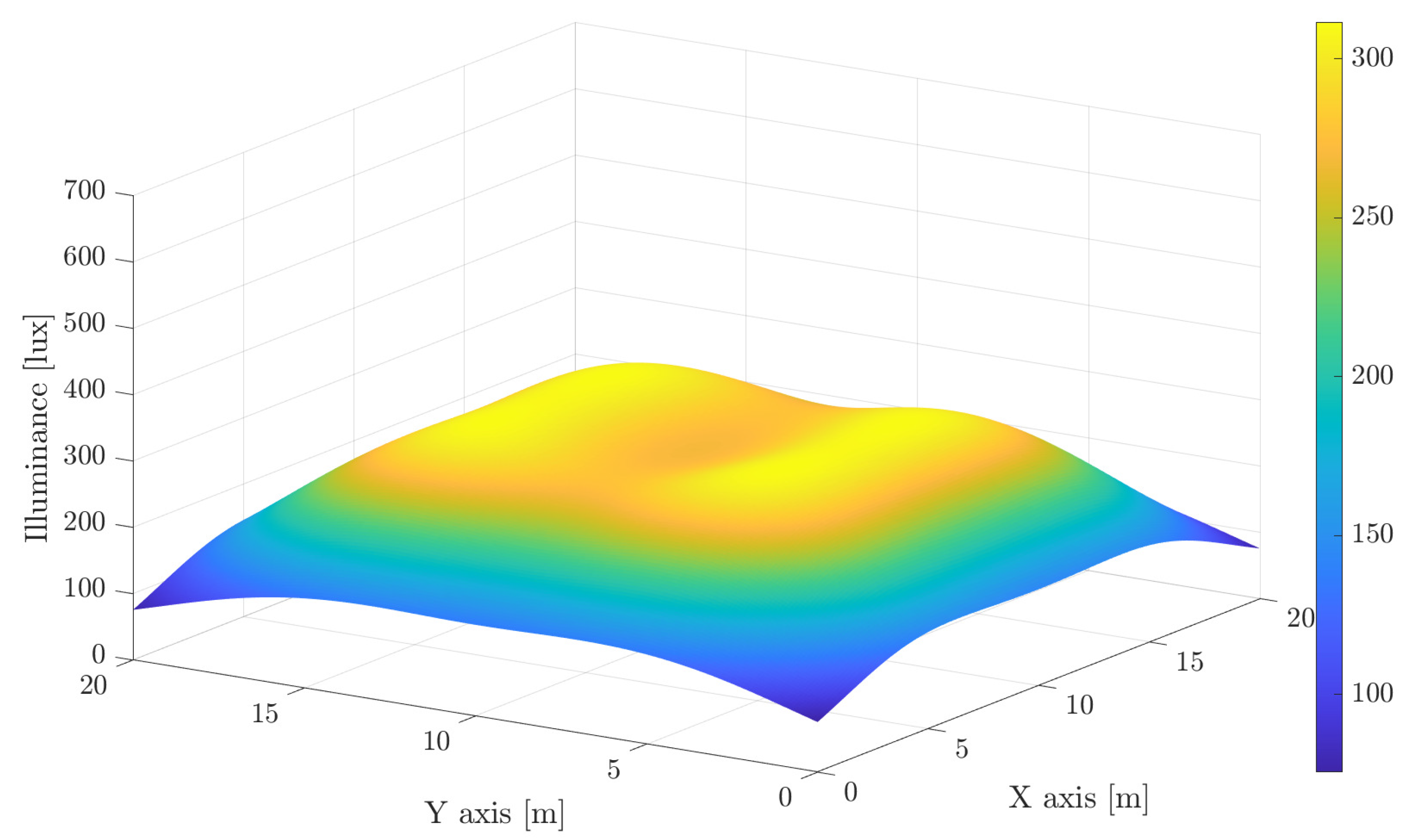
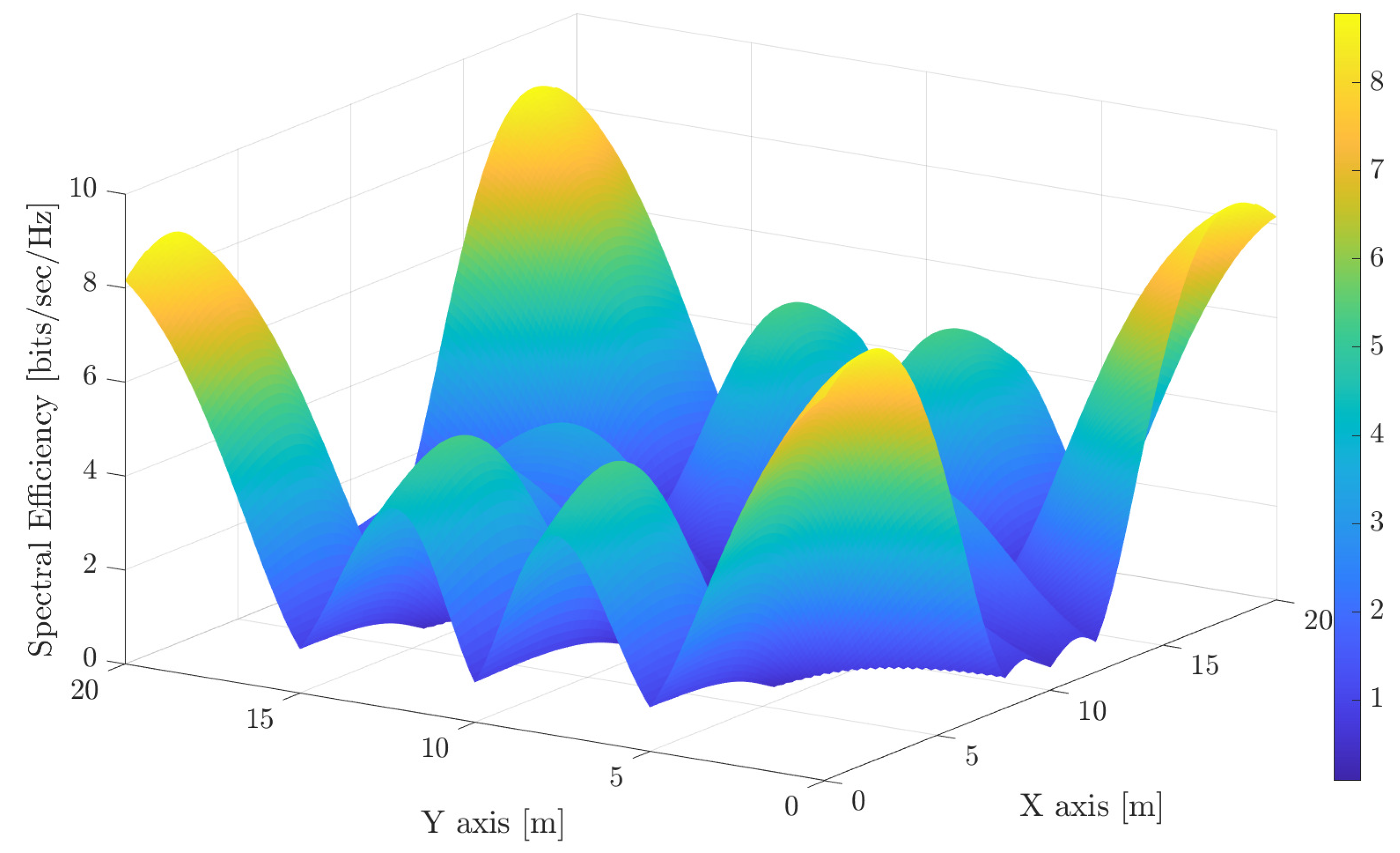




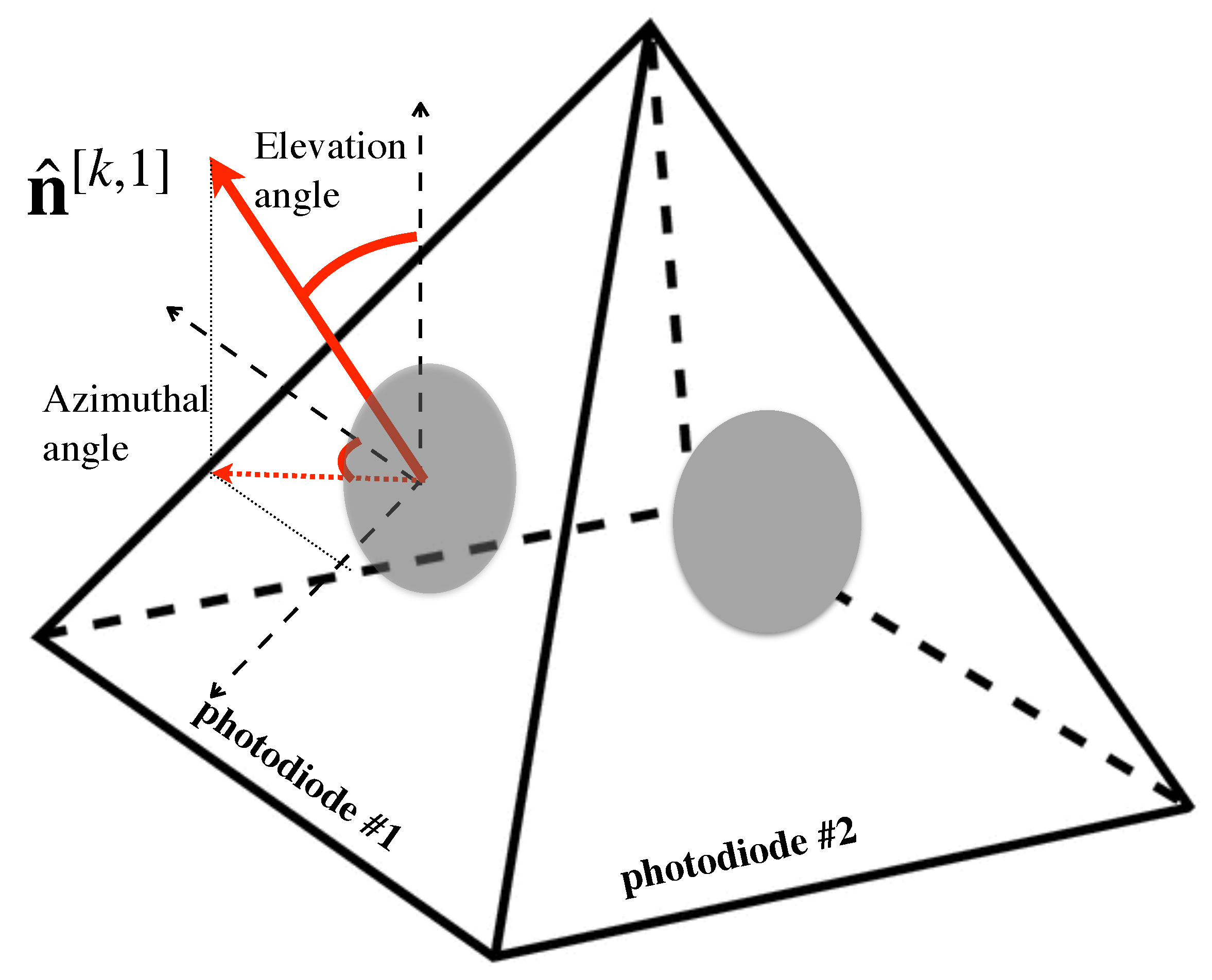
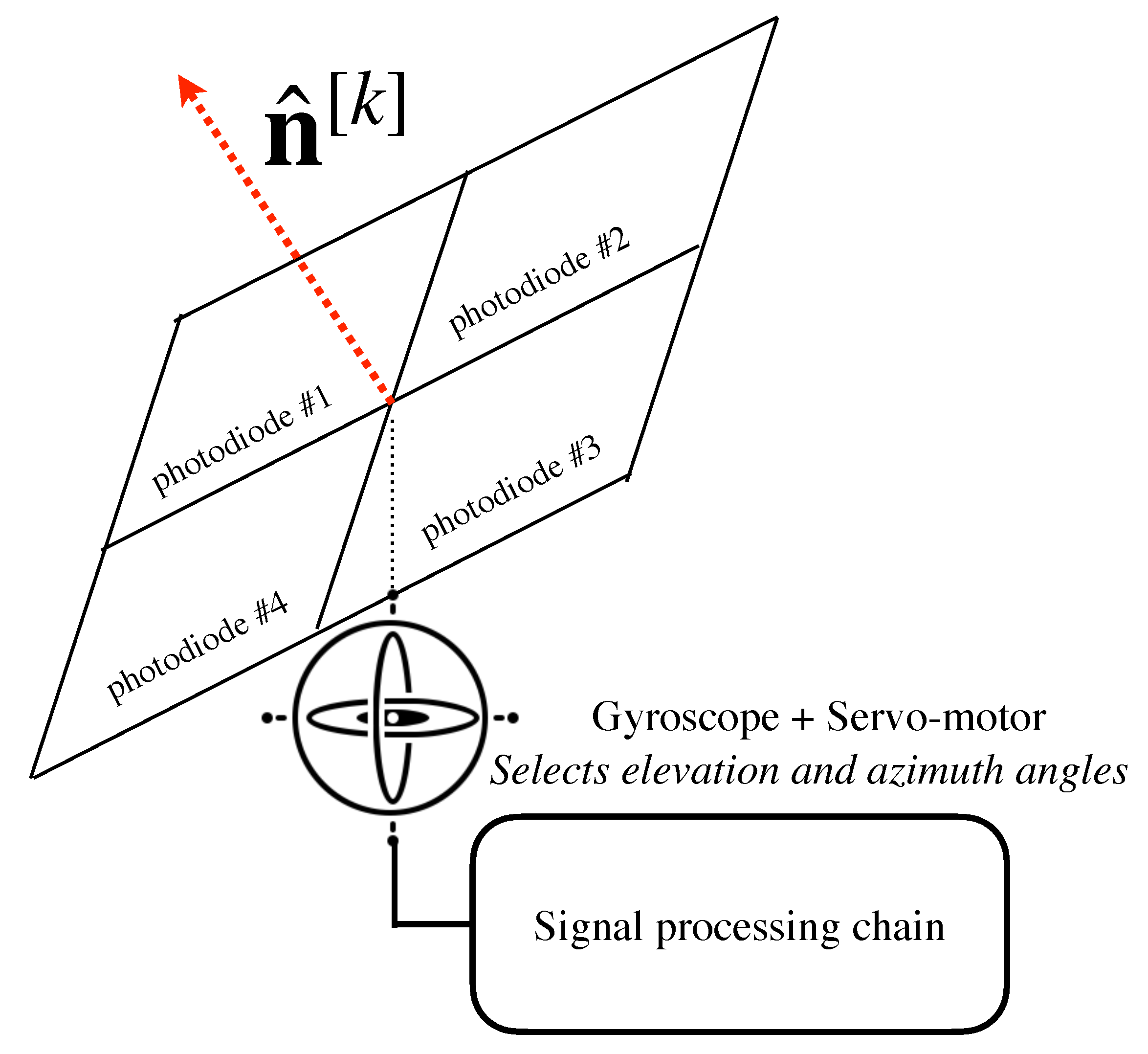

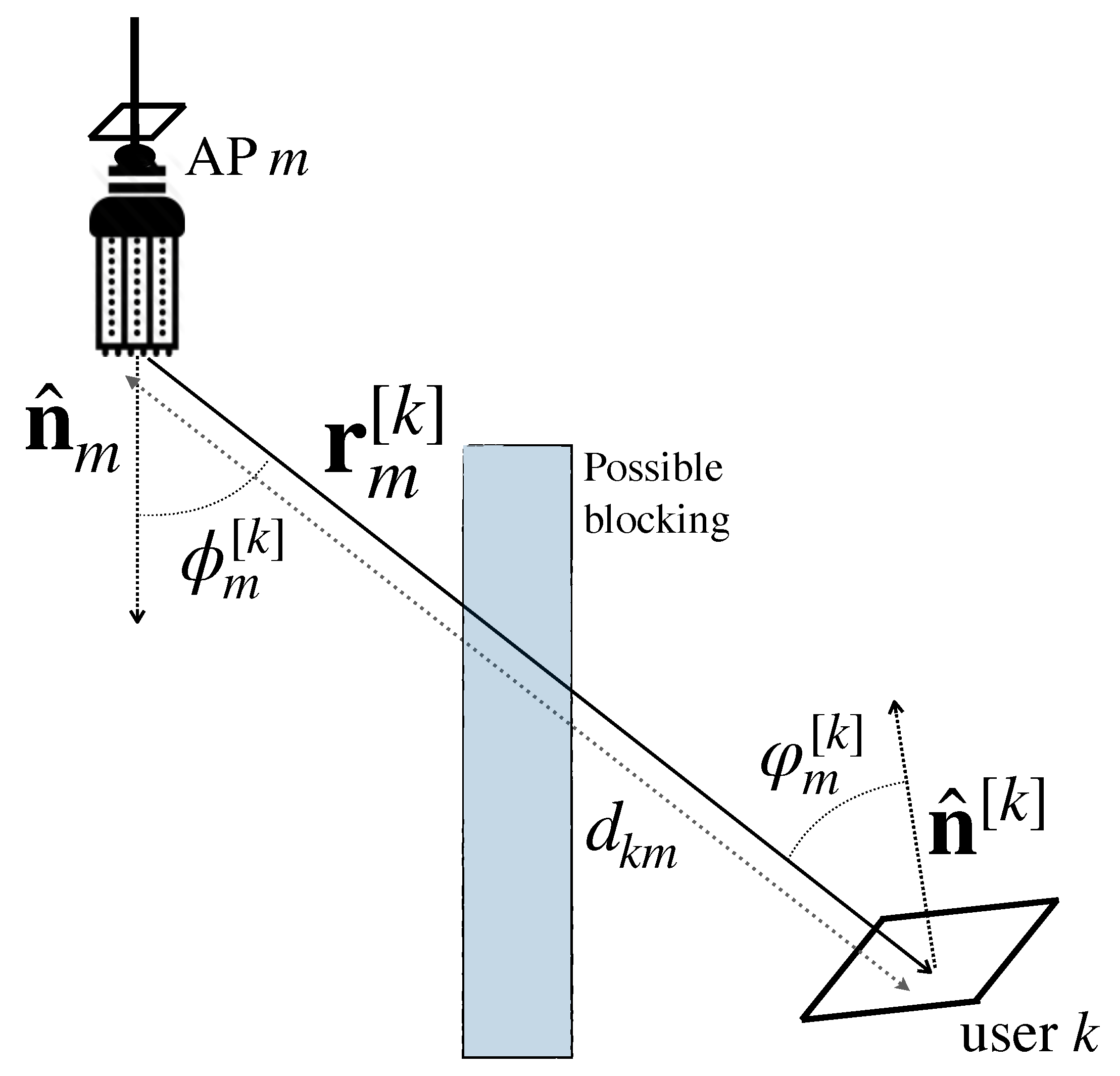
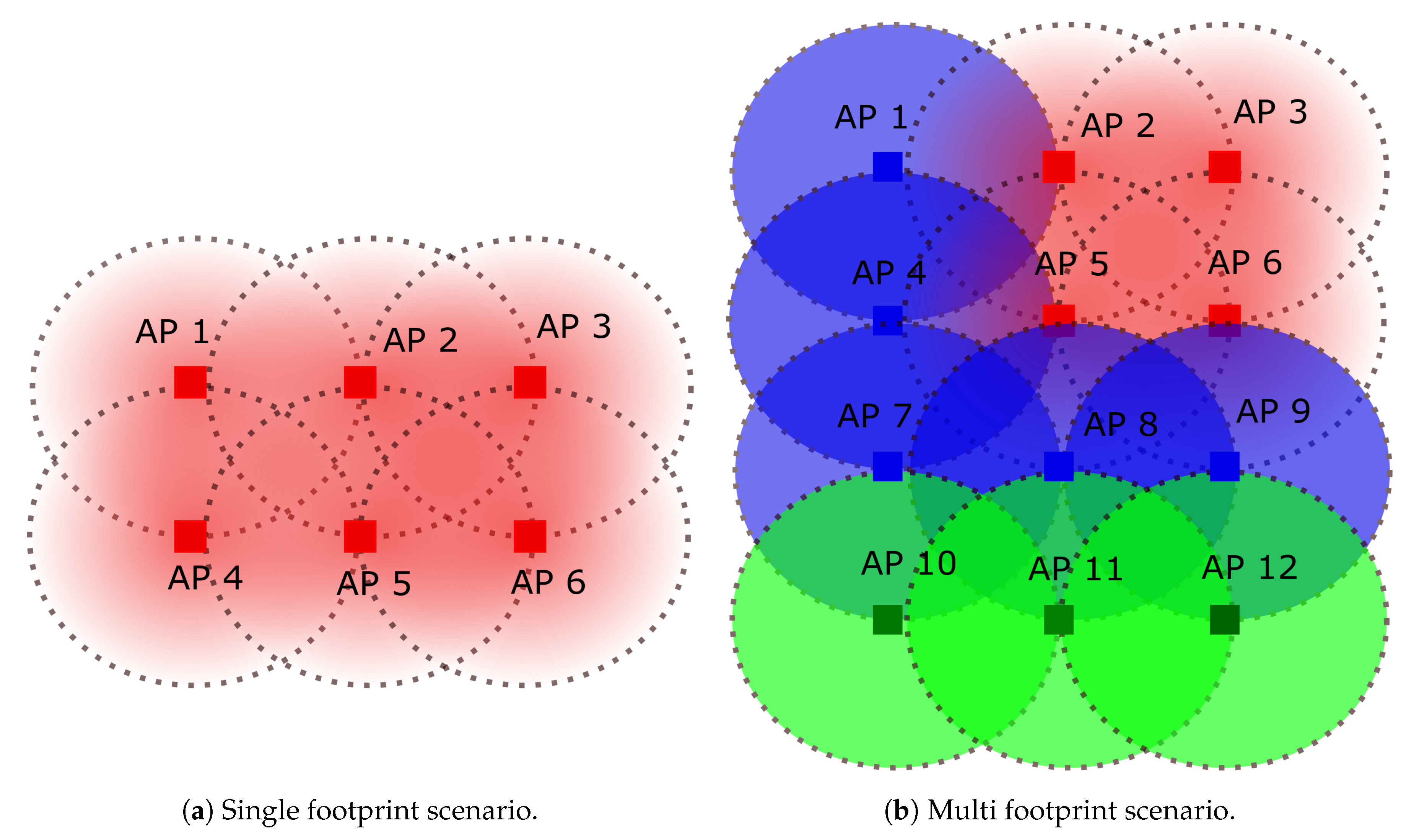
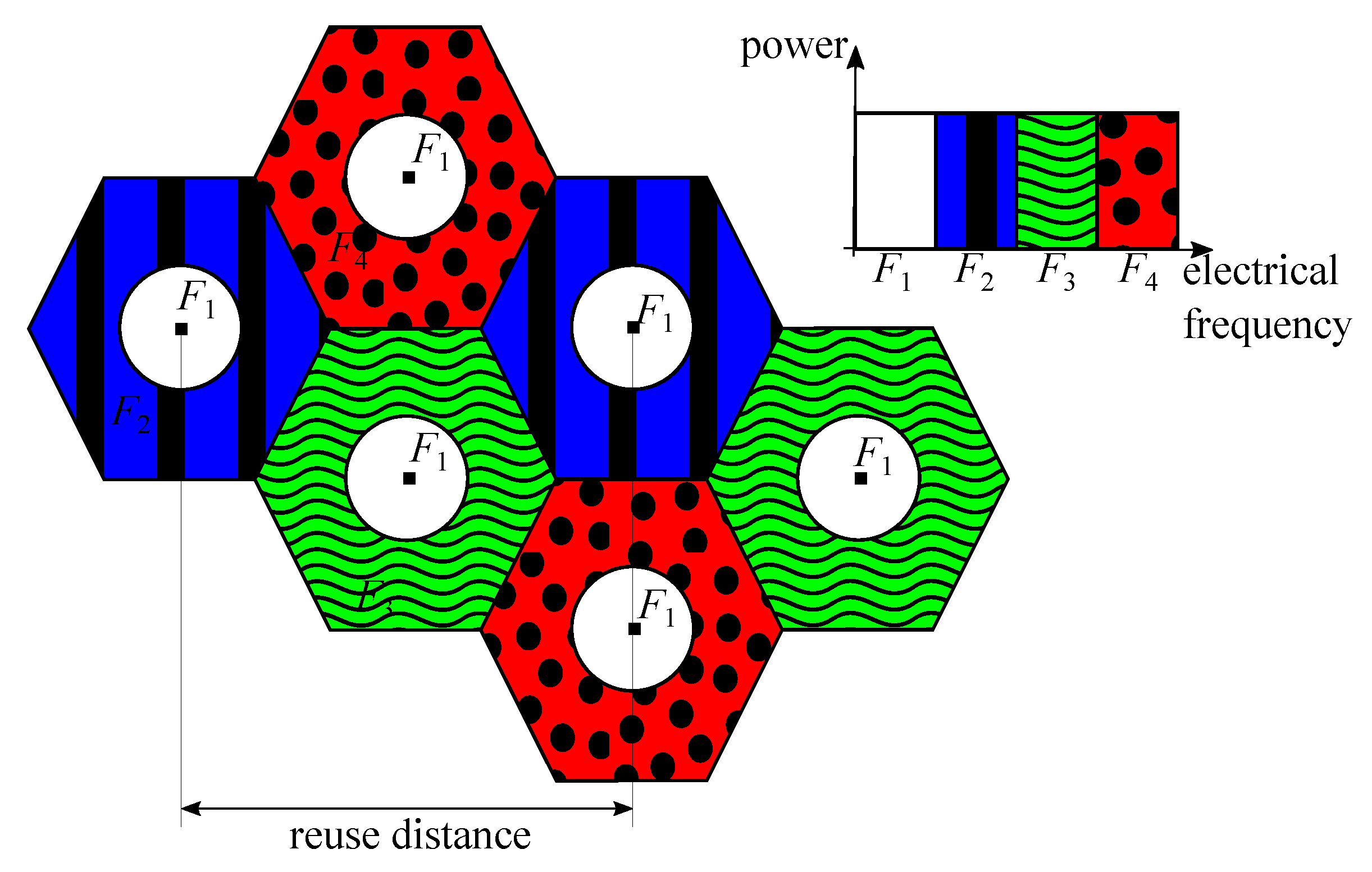

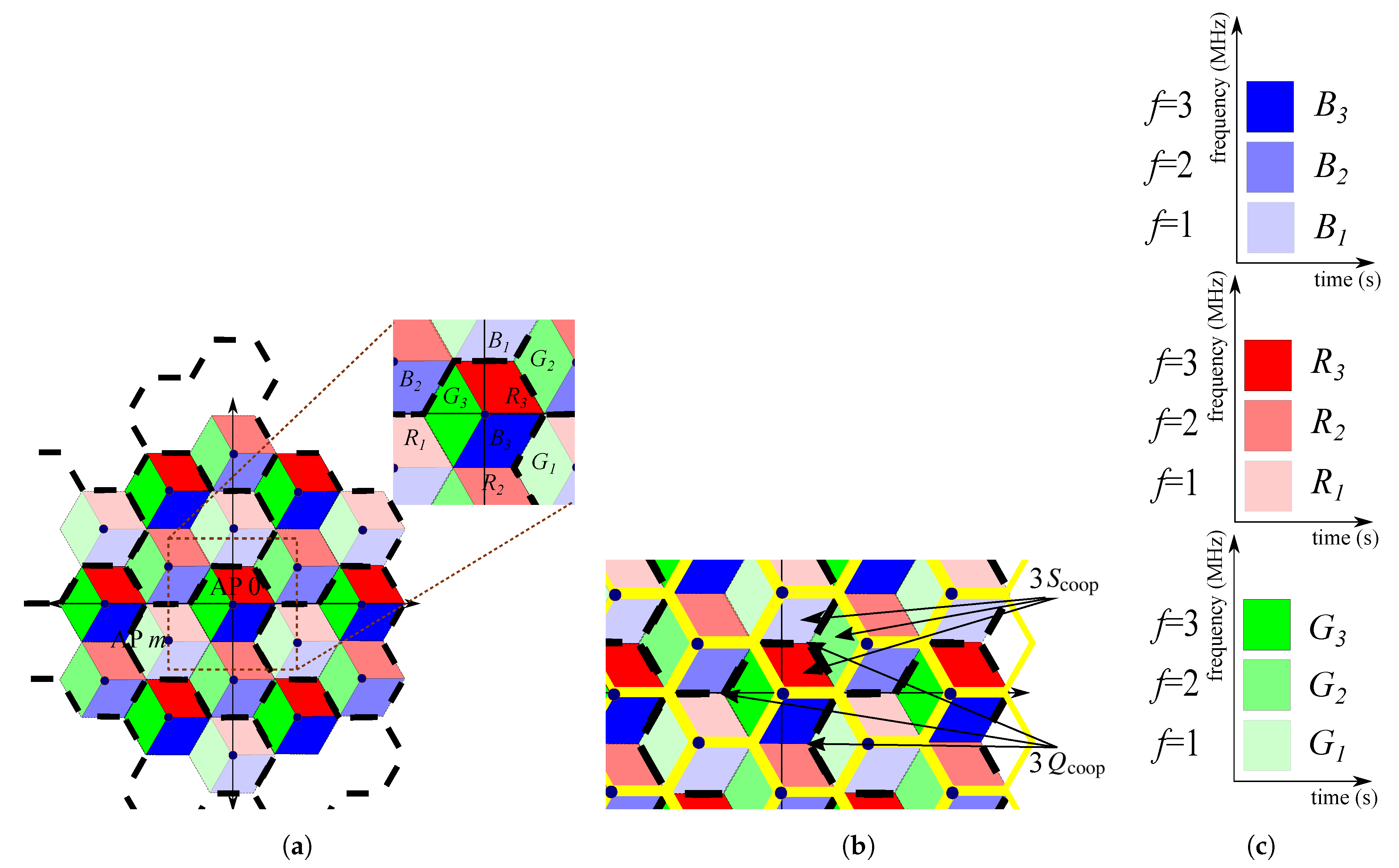




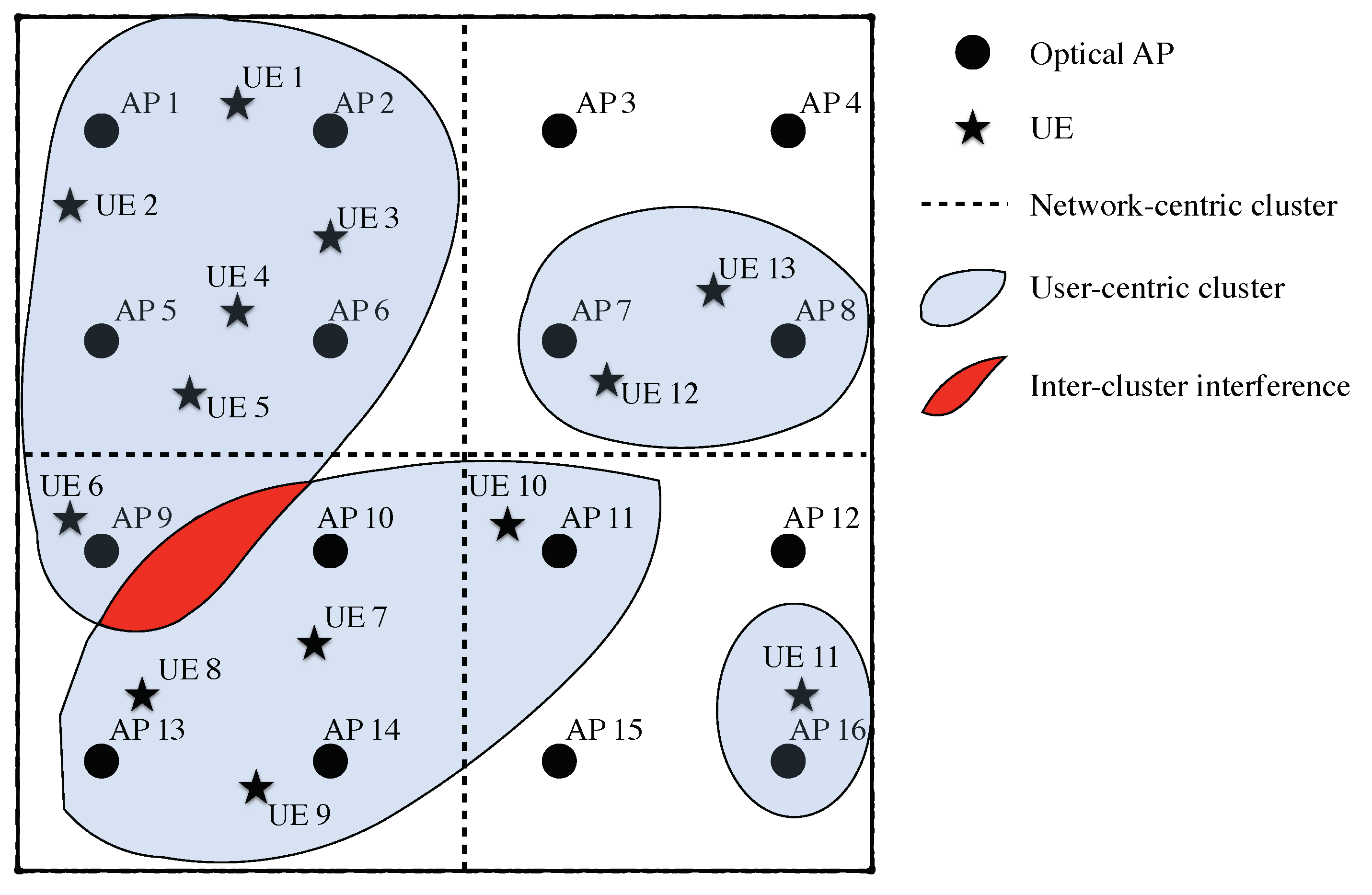
| ACO-OFDM | Asymmetrically clipping optical–orthogonal frequency division multiplexing |
| ADO-OFDM | Asymmetrically clipped direct current biased optical OFDM |
| ADR | Angle diversity receiver |
| AP | Access point |
| AWGN | Additive white Gaussian noise |
| BD | Block diagonalization |
| BER | Bit error rate |
| CSI | Channel state information |
| CU | Central unit |
| DCO-OFDM | DC-biased optical-orthogonal frequency division multiplexing |
| DD | Direct detection |
| DPC | Dirty paper coding |
| FDD | Frequency division duplex |
| FFR | Fractional frequency reuse |
| FFT | Fast Fourier transform |
| FoV | Field of view |
| FR | Frequency reuse |
| IFFT | Inverse fast Fourier transform |
| IM | Intensity modulation |
| IR | Infrared |
| JT-CoMP | Joint transmission—Coordinated multipoint |
| LED | Light emitting diodes |
| LoS | Line-of-sight |
| LTE | Long Term Evolution |
| MIMO | Multiple-input multiple-output |
| MMSE | Minimum mean squared error |
| M-PAM | Multi-level pulse amplitude modulation |
| M-PPM | Multi-level pulse position modulation |
| MRC | Maximum ratio combining |
| MSE | Mean squared error |
| NLoS | Non-line-of-sight |
| NOMA | Non-orthogonal multiple access |
| OOK | On-off keying |
| O-OFDM | Optical orthogonal frequency division multiplexing |
| PD | Photodiode |
| PLC | Power line communication |
| PWM | Pulse width modulation |
| QAM | Quadrature amplitude modulation |
| RGB | Red-green-blue |
| RF | Radio frequency |
| SDMA | Spatial division multiple access |
| SINR | Signal-to-interference-plus-noise ratio |
| SISO | Single-input-single-output |
| SNR | Signal-to-noise ratio |
| TDD | Time division duplex |
| TDMA | Time division multiple access |
| VLC | Visible light communications |
| ZF | Zero forcing |
| N | Number of sub-carriers |
| Maximum Optical Power | |
| Higher level current | |
| Measurement bandwidth | |
| Gain of hemispherical concentrator | |
| Field of View | |
| Spectral half-power bandwidth | |
| Shifting to shorter wavelength at non normal incidences | |
| Effective index of the input layer | |
| K | Number of users |
| Incident energy in W/cm | |
| Received signal by user k at time t | |
| Channel response vector between the M-th optical transmitter and user k at time t | |
| LoS channel component from optical AP m-th to user k | |
| Time-domain CIR for the front-end | |
| Frequency-domain data in n-th sub-carrier | |
| Reflection-based channel | |
| Channel from source to destination (NLoS component) | |
| Channel from relay to destination (NLoS component) | |
| t | Time instant |
| Incident angle for user k from AP m | |
| Responsivity of PD | |
| Reflectivity of the main region | |
| Variance of Gaussian noise | |
| Number of frequency sub-bands per color | |
| Q | Cluster size |
| Precoding vector associated to user k | |
| Resources allocated for channel estimation | |
| Resources allocated for feedback | |
| Number of samples of Cyclic Prefix | |
| Lower level current | |
| Area of detection of PD | |
| Time for peak transmission | |
| Generic angle of incidence | |
| Wavelength of transmitted signal | |
| Lambertian radiation index | |
| Effective index of the sparcer layer | |
| M | Number of Access Points |
| Lower bound capacity for user k | |
| Distance between m-th AP and user k | |
| Channel response for user k from Access Point m at instant t | |
| Contribution of the nLoS components | |
| Time-domain free-space channel component | |
| Frequency-domain CIR for the front-end | |
| Orientation vector of p-th PD of user k-th | |
| Channel from source to destination (LoS component) | |
| Channel from relay to destination (LoS component) | |
| Time-domain symbol to user k | |
| Irradiance angle for user k from AP m | |
| Radiation semi-angle | |
| Area of the room | |
| Average reflectivity | |
| Number of chip colors | |
| Number of resources | |
| Number of sector per cell | |
| P | Number of orthogonal Pilots |
| Resources allocated for coherence detection | |
| Symbol Period |
| Technique | Interference Mitigation | LoS-Link Blockage Avoidance | Complexity | Source |
|---|---|---|---|---|
| FFR | Yes | No | Low | [109,110] |
| JT-CoMP | Yes | Yes | High | [117,118,119,120,121] |
| Pre-defined JT-CoMP | Yes | Yes | Low | [31,46,104,111] |
| Relay-based | No | Yes | High | [45,125,126,127] |
| NOMA | Yes | No | Medium | [48,105,128,129] |
| SDMA | Yes | No | Medium | [130,131,132] |
| Technique | CSI Requirements | Interference Mitigation | LoS-Link BLOCKAGE Avoidance | Complexity | Source |
|---|---|---|---|---|---|
| OMIMO | Receiver | No | No | Low | [32,154,155] |
| DPC | Transmitters and Receivers | Yes | Medium | Very High | [160] |
| Linear ZF | Transmitters | Yes | Medium | High | [161,162,167] |
| BD | Transmitters and Receiver | Yes | High (ADRs) | High | [167] |
| max-min SINR | Transmitter | Yes | Medium | Medium | [76,166] |
| MMSE | Transmitter | Yes | Medium | High | [163] |
| CoMP-MMSE | Transmitters | Yes | High | Medium | [118] |
| BIA | Receiver | Yes | Medium (ADRs) | Medium | [29] |
Publisher’s Note: MDPI stays neutral with regard to jurisdictional claims in published maps and institutional affiliations. |
© 2021 by the authors. Licensee MDPI, Basel, Switzerland. This article is an open access article distributed under the terms and conditions of the Creative Commons Attribution (CC BY) license (http://creativecommons.org/licenses/by/4.0/).
Share and Cite
Céspedes, M.M.; Guzmán, B.G.; Jiménez, V.P.G. Lights and Shadows: A Comprehensive Survey on Cooperative and Precoding Schemes to Overcome LOS Blockage and Interference in Indoor VLC. Sensors 2021, 21, 861. https://doi.org/10.3390/s21030861
Céspedes MM, Guzmán BG, Jiménez VPG. Lights and Shadows: A Comprehensive Survey on Cooperative and Precoding Schemes to Overcome LOS Blockage and Interference in Indoor VLC. Sensors. 2021; 21(3):861. https://doi.org/10.3390/s21030861
Chicago/Turabian StyleCéspedes, Máximo Morales, Borja Genovés Guzmán, and Víctor P. Gil Jiménez. 2021. "Lights and Shadows: A Comprehensive Survey on Cooperative and Precoding Schemes to Overcome LOS Blockage and Interference in Indoor VLC" Sensors 21, no. 3: 861. https://doi.org/10.3390/s21030861






